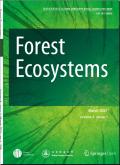Scale-dependent variations in photosynthetic processes mediate net primary productivity in temperate forests
IF 4.4
1区 农林科学
Q1 FORESTRY
引用次数: 0
Abstract
The net primary productivity (NPP) of forest ecosystems plays a crucial role in regulating the terrestrial carbon cycle under global climate change. While the temporal effect driven by ecosystem processes on NPP variations is well-documented, spatial variations (from local to regional scales) remain inadequately understood. To evaluate the scale-dependent effects of productivity, predictions from the Biome-BGC model were compared with moderate-resolution imaging spectroradiometer (MODIS) and biometric NPP data in a large temperate forest region at both local and regional levels. Linear mixed-effect models and variance partitioning analysis were used to quantify the effects of environmental heterogeneity and trait variation on simulated NPP at varying spatial scales. Results show that NPP had considerable predictability at the local scale, with a coefficient of determination (R2) of 0.37, but this predictability declined significantly to 0.02 at the regional scale. Environmental heterogeneity and photosynthetic traits collectively explained 94.8% of the local variation in NPP, which decreased to 86.7% regionally due to the reduced common effects among these variables. Locally, the leaf area index (LAI) predominated (34.6%), while at regional scales, the stomatal conductance and maximum carboxylation rate were more influential (41.1%). Our study suggests that environmental heterogeneity drives the photosynthetic processes that mediate NPP variations across spatial scales. Incorporating heterogeneous local conditions and trait variations into analyses could enhance future research on the relationship between climate and carbon cycles at larger scales.
光合作用过程的尺度依赖性变化调节温带森林的净初级生产力
森林生态系统净初级生产力(NPP)对全球气候变化下陆地碳循环的调节起着至关重要的作用。虽然生态系统过程对NPP变化的时间影响已被充分记录,但空间变化(从地方到区域尺度)仍未得到充分了解。为了评估生产力的尺度依赖效应,将生物群落- bgc模型的预测结果与中等分辨率成像光谱辐射计(MODIS)和生物特征NPP数据在温带大林区的局地和区域水平进行了比较。采用线性混合效应模型和方差划分分析,量化了不同空间尺度下环境异质性和性状变异对模拟NPP的影响。结果表明,NPP在局地尺度上具有较好的可预测性,决定系数(R2)为0.37,但在区域尺度上可预测性显著下降至0.02。环境异质性和光合性状共同解释了NPP局部变化的94.8%,由于这些变量之间的共同效应减弱,区域差异降低至86.7%。在局部尺度上,叶面积指数(LAI)占主导地位(34.6%),而在区域尺度上,气孔导度和最大羧化率的影响更大(41.1%)。我们的研究表明,环境异质性驱动了介导NPP在空间尺度上变化的光合作用过程。将异质局地条件和性状变异纳入分析,可以在更大尺度上加强气候与碳循环关系的研究。
本文章由计算机程序翻译,如有差异,请以英文原文为准。
求助全文
约1分钟内获得全文
求助全文
来源期刊

Forest Ecosystems
Environmental Science-Nature and Landscape Conservation
CiteScore
7.10
自引率
4.90%
发文量
1115
审稿时长
22 days
期刊介绍:
Forest Ecosystems is an open access, peer-reviewed journal publishing scientific communications from any discipline that can provide interesting contributions about the structure and dynamics of "natural" and "domesticated" forest ecosystems, and their services to people. The journal welcomes innovative science as well as application oriented work that will enhance understanding of woody plant communities. Very specific studies are welcome if they are part of a thematic series that provides some holistic perspective that is of general interest.
 求助内容:
求助内容: 应助结果提醒方式:
应助结果提醒方式:


